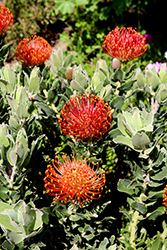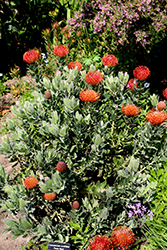Fri & Sat 8am - 8pm
Sun 8am - 7pm
Anytown, USA 12345
fax: 261.787.0463
e-mail: info@successgc.com


Plant Finder

Flame Giant Pincushion
Leucospermum cordifolium 'Flame Giant'
Height: 6 feet
Spread: 6 feet
Sunlight:
![]()
Hardiness Zone: 9b
Other Names: Giant Nodding Pincushion, Protea Pincushion
Description:
An attractive, upright shrub featuring large, long lasting, red pincushion flowers that mature to orange with yellow tips; great for cutting; like most Protea family plants, use very little slow release fertilizer with low phosphorus content
Ornamental Features
Flame Giant Pincushion features showy red pincushion flowers with orange overtones and yellow tips at the ends of the branches from mid winter to early spring. The flowers are excellent for cutting. It has dark green foliage with hints of silver which emerges light green in spring. The fuzzy oval leaves remain dark green throughout the winter.
Landscape Attributes
Flame Giant Pincushion is a multi-stemmed evergreen shrub with a mounded form. Its average texture blends into the landscape, but can be balanced by one or two finer or coarser trees or shrubs for an effective composition.
This is a relatively low maintenance shrub, and is best pruned in late winter once the threat of extreme cold has passed. It is a good choice for attracting birds and bees to your yard, but is not particularly attractive to deer who tend to leave it alone in favor of tastier treats. It has no significant negative characteristics.
Flame Giant Pincushion is recommended for the following landscape applications;
- Mass Planting
- Hedges/Screening
- Border Edging
- General Garden Use
- Container Planting
Planting & Growing
Flame Giant Pincushion will grow to be about 6 feet tall at maturity, with a spread of 6 feet. It tends to fill out right to the ground and therefore doesn't necessarily require facer plants in front, and is suitable for planting under power lines. It grows at a medium rate, and under ideal conditions can be expected to live for approximately 30 years.
This shrub should only be grown in full sunlight. It prefers dry to average moisture levels with very well-drained soil, and will often die in standing water. It is considered to be drought-tolerant, and thus makes an ideal choice for xeriscaping or the moisture-conserving landscape. This plant should be periodically fertilized throughout the active growing season with a specially-formulated acidic fertilizer. It is not particular as to soil type, but has a definite preference for acidic soils, and is able to handle environmental salt. It is somewhat tolerant of urban pollution. This is a selected variety of a species not originally from North America.
Flame Giant Pincushion makes a fine choice for the outdoor landscape, but it is also well-suited for use in outdoor pots and containers. Because of its height, it is often used as a 'thriller' in the 'spiller-thriller-filler' container combination; plant it near the center of the pot, surrounded by smaller plants and those that spill over the edges. It is even sizeable enough that it can be grown alone in a suitable container. Note that when grown in a container, it may not perform exactly as indicated on the tag - this is to be expected. Also note that when growing plants in outdoor containers and baskets, they may require more frequent waterings than they would in the yard or garden.

